Welcome to the Letters 1916-1923 project

We are delighted that you are interested in becoming a Letters 1916-1923 transcriber. Transcribing means that you will help us created a digital copy of a hand-written or type-written item in our collection. More than 1500 people have transcribed letters, postcards, telegraphs or memos since the first launch of our project, and as our collection continues to grow, welcome new volunteers. Since autumn 2017, we have collected correspondence from the period of the Easter Rising till the end of the Civil War. These letters cover all aspects of life from love and friendship to political activism. So join us and discover Irish life a century ago!
Step-by-step guide to becoming a transcriber
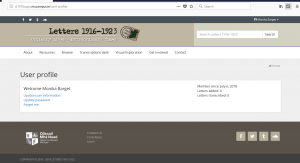 |
1. Create a user profile:
The first thing you should do is log-in or set up a user profile on the system. With a personal user name and password, you can access our pages for volunteers. |
 |
2. Access the transcription desk:
Log in to your user account and go to the transcription desk linked in the main menu. Here you will find letters to work on. |
 |
3. Use filters to find a letter that needs transcription or review:
Once you enter the transcription desk, you will see letters to transcribe. To find a letter that interests you, use the filters on the left, e.g. authors, dates or keywords. Each letter has a progress bar that indicates if a letter has already been completed. Letters that are 100% completed are currently awaiting review by an administrator. So please choose a letter that is less than 100% complete. You may either work on an untouched letter or review and improve letters others have transcribed. We have found that as more people edit one letter, the better the transcriptions get. Besides, some letters are very long and several volunteers can work on one folio each. If another volunteer is working on a letter, you will receive a notification that the letter is blocked. You may come back to it later and transcribe another letter in the meantime. Do scroll down the page. Often there are untouched letters to transcribe quite a bit down. |
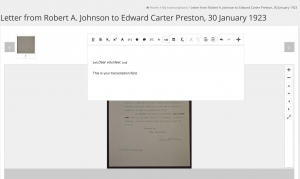 |
4. Select one letter and transcribe/edit it in the box below the scan:
After selecting a letter you would like to work on, the letter images and a transcription form open up on your screen. Please note that you do not have to print the letters to transcribe them, they can all be transcribed online in the textbox below the letter. The textbox can be detached from the letter image and moved across the screen if you keep the left button of your mouse pressed down. You can re-position the textbox as often as you like. Please use the zoom on the right of the image to blow up a letter in small script. |
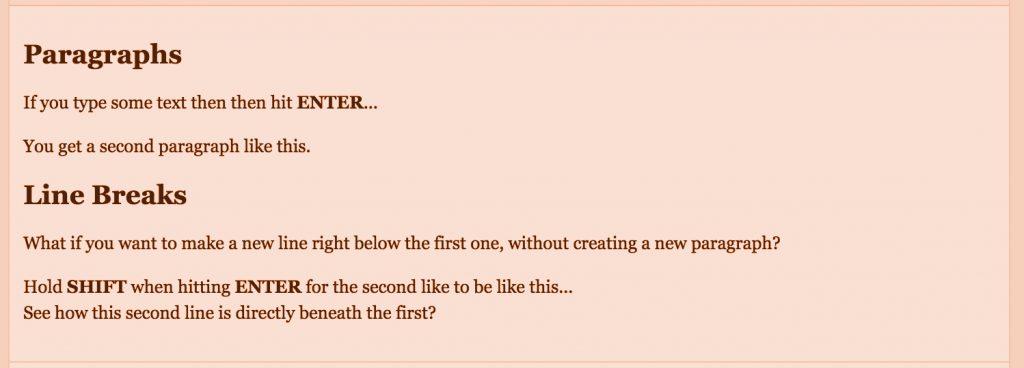 |
5. Type out the letters as you see them, including mistakes in the original texts:
Please type the letter out as you see it in the original image, respecting paragraphs and line-breaks as well as highlighted or deleted words.
SHIFT+ENTER creates a linebreak! ENTER creates a paragraph! It is very important to differentiate these two. Besides, we do not correct spelling mistakes in the original letters as these mistakes tell us something about language usage and educational standards at the time. |
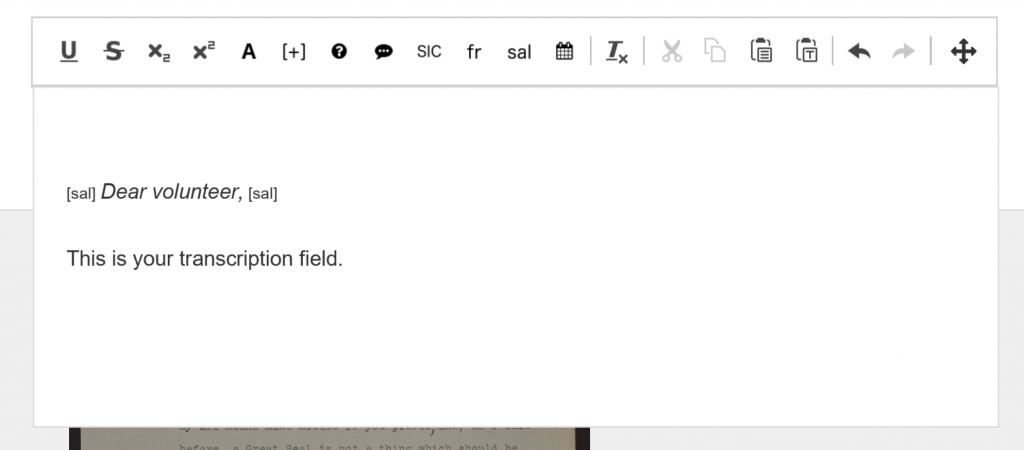 |
6. Use the buttons in the transcription field to format your text:
The buttons above the transcription field will help you mark additional formatting. Address lines and salutes, for instance, have to be placed in a tag. Open our sample letter to see what it looks like. Each folio of a letter needs to be transcribed in a separate box. A new box will open automatically as soon as you click on the next letter image. |
 |
7. Transcriptions are saved automatically:
Thanks to our auto-save, you do not need to worry about saving your edits before logging out. Anything you add to the textboxes will be saved within a few seconds. |
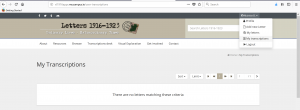 |
8. Review your transcriptions:
You can review all your transcriptions and edits in the “my transcriptions” section in your personal profile. This section keeps track of all the letters you have worked on. You can always go back to your user profile and update them. Furthermore, you may use this information to prove your voluntary work to volunteering agencies or educational bodies. |
| 9. Do not hesitate to ask the Letters 1916-1923 team for help:
Although this may look challenging at first, do not be afraid of making mistakes! You and other volunteers can easily go back to the letter and update the transcription. If you have any questions, please email us or join our community on Twitter and Facebook. Social media are a great platform to meet other Letters 1916-1923 volunteers and to receive regular updates about our project. We are happy to help you with any step of the process. |
LETTERS 1916-1923 FREQUENTLY ASKED QUESTIONS
WHAT ARE THE BENEFITS OF VOLUNTEERING FOR THE PROJECT?
Volunteers are part of an online community who are creating a collection of letters that bring Irish history to life in terms of a wide variety of themes, including literature and art, the Great War, politics, business, and ordinary life. This new collection, from public institutions as well as private sources, sheds a new light on this key period in Ireland’s history. Through these letters we are bringing to life the written words, the last words, the unspoken words, and the forgotten words. We are creating an online collection for the public, by the public, which is adding a new perspective to the events of the period, a confidential and intimate glimpse into early 20th-century life in Ireland, as well as how Irish politics was received and viewed internationally.
WHERE TO START?
In order to upload a letter or start transcribing the letters, you need to create an online account to log in.
HOW TO TRANSCRIBE A LETTER?
Before you start transcribing the letters, read the instructions provided above and take a careful look at the transcription desk.
WHY TRANSCRIBE?
The Letters 1916-1923 Project is in the process of creating a digital collection of letters which will be used in a further research using digital humanities methodologies. In order to achieve that, the letters have to be transcribed, so the text will be digital and computer-readable. This digital text will allow full text search of the collection, which is not possible using images of handwritten letters at the moment.
HOW CAN I HELP BEYOND TRANSCRIBING?
If you (or any of your friends or relatives) have a letter written between 1 November 1915 and 31 December 1923, you can contribute to the project by uploading your letter to the system.

